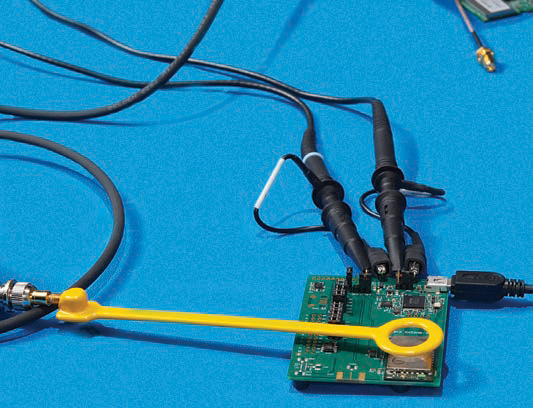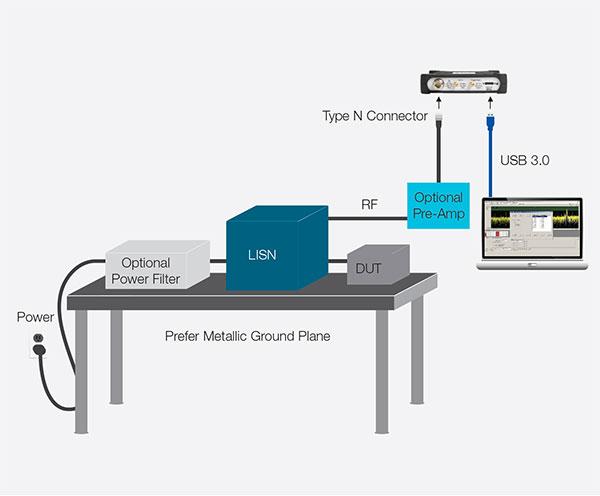연락처
텍트로닉스 담당자와 실시간 상담 6:00am-4:30pm PST에 이용 가능
전화 문의
9:00am-6:00PM KST에 이용 가능
다운로드
매뉴얼, 데이터 시트, 소프트웨어 등을 다운로드할 수 있습니다.
피드백
EMI 및 EMC 테스트 이해: 전도성 및 복사성 방출
프로젝트의 50%가 최초 EMI/EMC 테스트에 실패한다는 사실을 알고 계십니까? Intertek Testing Services의 보고서에 따르면, EMC 원칙 적용 실패, EMI/EMC 지식 부족, 규정의 부정확한 적용, 회로 소자 간의 예측 불가능한 상호 작용 또는 최종 제품에 호환되지 않는 모듈이나 하위 어셈블리 포함 문제 등으로 인해 제품의 대략 절반 정도가 초기 EMI/EMC 테스트를 통과하지 못합니다.
사전 컴플라이언스 테스트를 수행하면 전체 EMI 컴플라이언스 테스트의 실패율을 낮출 수 있어 시간과 비용이 절약될 수 있습니다. EMI 테스트는 특히 전자파 간섭의 원인을 식별하고 완화하기 위한 디버깅을 포함하여 제품이 규제 기준을 충족하도록 합니다. 의료, 자동차, 군사 애플리케이션은 물론 멀티미디어 애플리케이션용 제품을 설계하는 회사도 사전 컴플라이언스 테스트 설정에 투자하여 이익을 얻을 수 있습니다. 이 페이지에서는 사전 컴플라이언스 테스트를 제품 개발 단계에 추가하여 제품 개발을 가속화하고 제품 비용을 절감할 수 있는 방법에 대해 논의합니다. EMI/EMC 테스트의 기본 사항에 대해 자세히 알아보십시오.
EMI/EMC 테스트란 무엇입니까?
전자기적 적합성(EMC)과 전자기 간섭(EMI) 시험은 전자기기들이 의도된 환경에서 원활히 동작하면서 불필요한 전자기 간섭을 일으키거나 영향을 받지 않도록 보장하는 데 핵심적인 과정입니다.
EMI 테스트는 장치에서 발생하는 전자기 방출(emission)을 측정하여 다른 전자 장비에 간섭을 일으키지 않음을 확인합니다 중요합니다. 과도한 방출은 주변 장치의 작동을 방해하여 오작동이나 고장을 일으킬 수 있으므로 이는 중요합니다.
EMC 테스트는 전자파 간섭이 있을 때 장치가 올바르게 작동할 수 있는 능력을 평가합니다. 이를 통해 외부 전자기장에 영향을 받지 않고 장치가 의도대로 동작함을 보장합니다.
완벽한 EMI/EMC 사전 적합성 테스트 솔루션
Tektronix는 비용 효율적으로 빠르게 진행할 수 있도록 소프트웨어, 스펙트럼 분석기, 액세서리 및 EMC 근거리장 프로브 등의 완벽한 EMI/EMC 사전 컴플라이언스 테스트 솔루션을 제공합니다.
EMC 소프트웨어
Tektronix EMI/EMC 사전 적합성 솔루션은 SignalVu-PC와 EMCVu 소프트웨어에서 시작됩니다. SignalVu-PC의 플러그인으로서, EMCVu는 모든 사전 적합성 요구를 위한 단일 사용자 인터페이스를 제공합니다.
스펙트럼 분석기
빠르고 정확한 측정값을 제공하여 EMI/EMC 문제를 신속하게 확인할 수 있도록 텍트로닉스는 경제적인 실시간 스펙트럼 분석기의 모든 제품을 선보이고 있습니다. 실시간 스펙트럼 분석기는 비정상적인 EMI 버스트를 캡처할 수 있는 기존 스윕에 비해 상당히 많은 이점을 제공합니다.
EMI/EMC 테스트 장비
사용하기 쉬운 사전 적합성 소프트웨어
EMCVu가 있는 SignalVu-PC
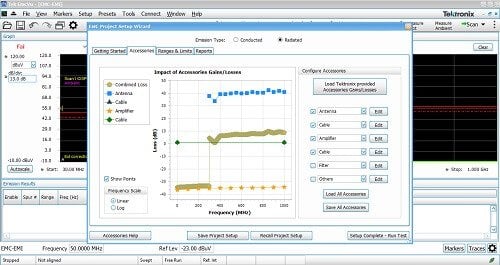
Tektronix EMI/EMC 사전 컴플라이언스 솔루션은 EMCVu 소프트웨어가 탑재된 SignalVu-PC에서 시작됩니다. EMCVu는 모든 사전 적합성 측정 기능을 내장한 직관적인 사용자 인터페이스를 제공합니다. 간단히 EMCVu 소프트웨어 라이선스를 구매하면 SignalVu-PC에서 그 기능을 활용할 수 있습니다.
저렴한 사전 적합성
실시간 스펙트럼 분석기
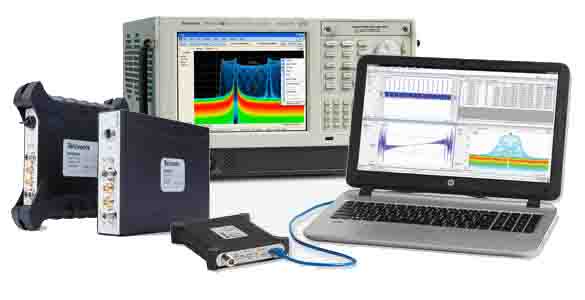
Tektronix 실시간 스펙트럼 분석기는 기존 스펙트럼 분석기로는 놓치기 쉬운 방출 신호를 포착할 수 있도록 도와줍니다. 모든 Tektronix 스펙트럼 분석기에는 광범위한 스펙트럼 분석을 위한 SignalVu 소프트웨어가 포함되어 있습니다.
고도로 통합된 오실로스코프에서 혼합 도메인 분석
4/5/6 시리즈 MSO 오실로스코프
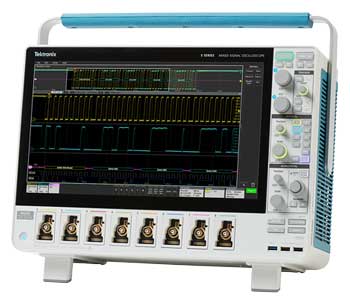
이와 같은 다기능 오실로스코프는 독창적인 Spectrum View 기능을 제공하여, 모든 아날로그 채널에서 시간 영역 파형, 스펙트럼, 혹은 두 가지를 동시에 표시할 수 있습니다. 시간 영역과 주파수 영역 플롯이 동기화되어 어떤 신호가 피해 신호(victim)이고, 어떤 신호가 간섭 신호(aggressor)인지 판단하는 데 도움을 줍니다.
EMC 사전 컴플라이언스 테스트의 장점
새로운 설계를 신속하게 시장에 출시하려고 할 때, 설계 주기 말미에 컴플라이언스 테스트에 실패하여 업무가 지체되는 것을 바랄 리는 만무합니다. 작업 공정에 사전 컴플라이언스 솔루션을 통합하면 많은 이점을 얻을 수 있습니다.
- 출시 시기가 지연되고 개발 비용이 증가할 수 있는 잠재적인 EMI/EMC 문제를 조기에 확인
- EMI/EMC 관련 비용 절감
- 테스트 시설에 입고하기 전 제품에 대한 신뢰성 증대
- 설계 변경 시 미치는 영향에 대한 즉각적인 피드백
- 일정에 맞춘 테스트 유연성
포괄적인 가이드를 통해 사전 컴플라이언스 EMC 테스트에 대해 계속 알아보세요.

우수한 EMC 설계 기술은 설계 초기 단계에 도입한다면 구현하는 데 큰 어려움이 없습니다. 나중에 EMC 요구 사항을 충족하기 위해 설계를 수정해야 할 경우에는 훨씬 더 어려워집니다.
EMI/EMC 시험 설정의 쉬운 설명
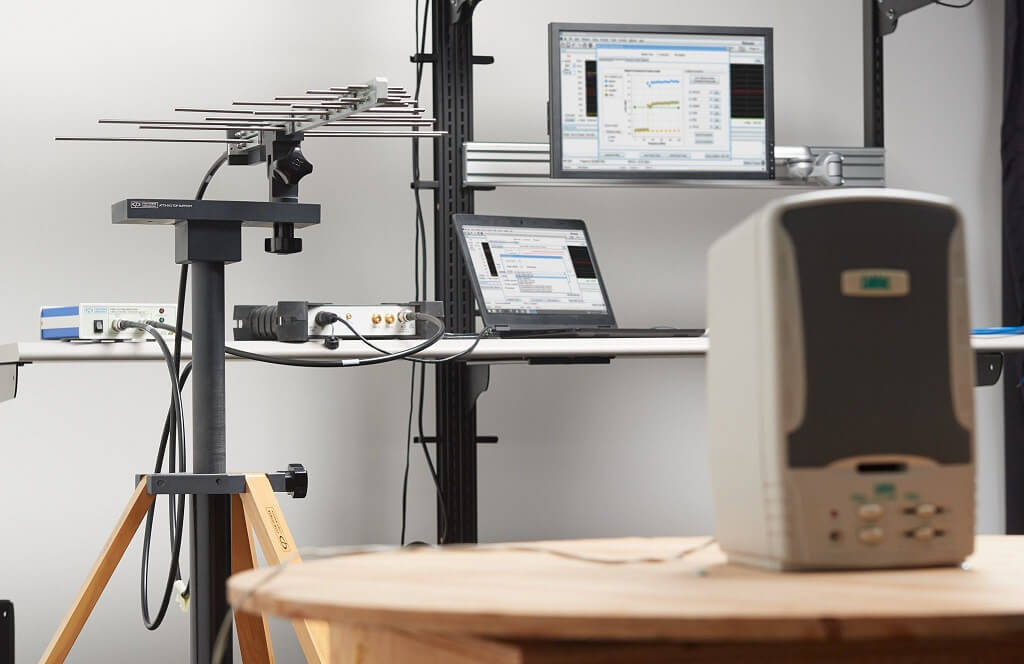
텍트로닉스 RSA500 USB 스펙트럼 분석기를 사용하는 일반적인 복사성 테스트 설정
EMI/EMC 사전 컴플라이언스 테스트는 어렵거나 시간을 지나치게 많이 허비하지 않습니다. 고객의 목소리(V0C)를 반영하여 텍트로닉스는 복사성 및 전도성 측정용 사전 컴플라이언스 테스트를 제공하기 위해 사용하기 쉽고 기능이 간단한 차세대 소프트웨어를 개발했습니다.
EMI/EMC 사전 컴플라이언스 테스트 설정 작업은 SignalVu-PC에서 시작됩니다. 이 최신 버전의 SignalVu-PC는 현재 EMCVu라는 추가 옵션과 함께 제공됩니다. EMCVu는 사용하기 쉬운 설정 마법사(Wizard) 기능과 내장형 표준 및 푸시 버튼 액세서리 설정 기능을 갖추고 있습니다. 야외 시험장(OATS)을 마련하든, 실험실에서 테스트하든 상관없이 EMCVu는 캡처 기능과 측정값에서 주변 노이즈를 제거하는 기능을 간소화하여 무반향실을 갖추지 않고도 사전 컴플라이언스 테스트의 정확도를 높일 수 있습니다.
실시간 스펙트럼 분석기 및 액세서리용 EMCVu를 사용해 전도성 및 복사성 방출 사전 컴플라이언스 테스트를 수행하는 방법에 대해 알아보려면 여기서 애플리케이션 노트를 다운로드하십시오.
30일 간 무료로 사용할 수 있는 EMCVu 평가판에 관심이 있는 경우 아래 버튼을 클릭하십시오.
텍트로닉스 EMI/EMC 사전 적합성 솔루션에서 지원하는 표준
텍트로닉스의 EMCVu 사전 컴플라이언스 소프트웨어는 많은 장치 유형에 대해 CISPR, FCC, MIL-STD 등의 EMC 표준을 지원합니다. 테스트를 자동화할 수 있도록 EMCVu에서는 제품이 판매될 지역과 제품에 적용되는 표준을 선택할 수 있는 내장형 표준 규격을 제공합니다. 또한 EMCVu는 선택한 표준의 주파수 범위 또는 한계를 설정할 수 있는 기능을 갖춰 규격에 포함되지 않은 테스트도 임으로 구성할 수 있습니다.
지원되는 표준을 간략하게 요약하면 다음과 같습니다.
| 시장 부문 | 장비 유형 | 표준 | ||||
|---|---|---|---|---|---|---|
| IEC/CISPR | CENELEC/EN | FCC | MIL-STD | DEF-STAN | ||
| ISM 의료 | 산업, 과학 및 의료 장비 | CISPR 11 | EN 55011 | CFR Title 47 Part 18 | ||
| 의료 전기 기기 | EN 60601-1-2 | |||||
| 자동차 | 차량, 선박 및 내연 기관 | CISPR 12 | EN 55012 | CFR Title 47 Part 15(*) | ||
| 탑재 차량의 구성 요소 및 모듈 | CISPR 25 | EN 55025 | ||||
| 멀티미디어 | 음향 및 TV 방송 수신기 | CISPR 13 | EN 55013 | CFR Title 47 Part 15 | ||
| 정보 기술 및 통신 장비(ITE) | CISPR 22(EN55032로 대체됨) | EN 55022(EN55032로 대체됨) | ||||
| 전문 오디오/비디오/멀티미디어 장비 | CISPR 32(CISPR 13 및 22 대체) | EN 55032 | ||||
| 어플라이언스 | 전기 장치, 가정용 어플라이언스 및 도구 | CISPR 14-1 | EN 55014-1 | CFR Title 47 Part 15 | ||
| 조명 기구 | 형광등 및 조명 기구 | CISPR 15 | EN 55015 | CFR Title 47 Part 15 | ||
| 군사 | 군사 장비 및 시스템 | MIL-STD-461G | DEF-STAN 59-411 | |||
| 범용 | 주거, 상업 및 경공업 환경 | IEC 61000-6-3 | EN 61000-6-3 | 해당 없음 | 해당 없음 | 해당 없음 |
디버그 작업을 가속화하기 위한 문제 해결 팁
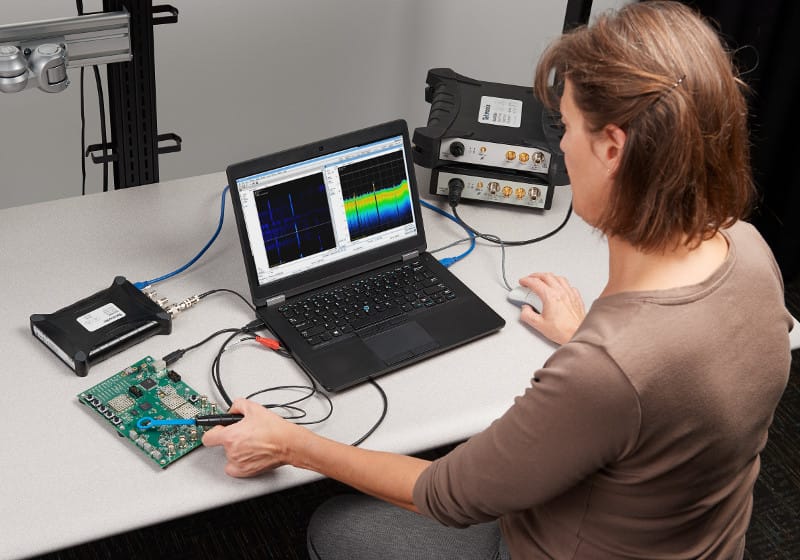
최종 제품 인증 테스트에 시간과 비용을 투자하기 전에 장치가 테스트 시설로 이동할 준비가 되었다는 확신을 얻고자 합니다. 문제가 생기면 문제 영역에 빠르게 초점을 맞춰 원인을 확인하고 많은 비용이 소요되는 지연 문제 없이 교정 조치를 취할 수 있는 적합한 도구가 필요합니다.
효율적으로 디버그하려면 문제 영역을 빠르게 확인하고, 간헐적 위반 영역을 캡처하는 신호 식별력 레벨을 제공할 수 있는 솔루션을 찾아보십시오. 이 솔루션은 하드웨어와 소프트웨어가 결합된 형태로 제공됩니다.
소프트웨어 솔루션에서 확인해야 하는 기능은 다음과 같습니다.
- 관심 주파수에서 비실패/제로를 우회할 수 있는 준피크 탐지기
- 특정 고조파만 테스트하고 인근 필드 프로브를 사용해 보드에서 발생한 방출 영역을 확인할 수 있는 고조파 검사
- 알려진 주파수의 고조파에서 방출을 확인할 수 있는 고조파 마커
- 피시험 장치(DUT)와 주변 소음, 장치의 이전 반복 사항을 비교할 수 있는 다중 추적
- 실패가 간헐적인지, 반복적인지 확인할 수 있는 자동 또는 수동 다중 실패 재측정
- 동일한 사용자 구성 보고서에 다양한 형식으로 여러 측정값 보고
하드웨어를 갖춘 실시간 스펙트럼 분석기에서는 EMI 디버그가 훨씬 더 수월합니다. 실시간 스펙트럼 분석기에서 제공하는 이점은 다음과 같습니다.
- 일시적/간헐적 신호를 캡처할 수 있는 기능
- 동일한 주파수에서 여러 소스를 디버그할 수 있는 기능
- 즉각적인 피드백 – 기존 스윕 스펙트럼 분석기 스윕은 시간이 더 오래 걸려 중요한 신호를 캡처하지 못할 수 있습니다.
텍트로닉스의 EMI 사전 컴플라이언스 테스트용 실시간 스펙트럼 분석기를 사용하는 방법에 대해 자세히 알아보려면 당사 블로그(여기)를 확인하십시오. 문제 해결 기술에 대한 추가 정보는 아래 버튼을 클릭하면 다운로드할 수 있는 ‘실용적인 EMI 문제 해결’ 애플리케이션 노트에 나와 있습니다.
어플리케이션 노트 다운로드혼합 도메인 오실로스코프로 EMI 문제 해결
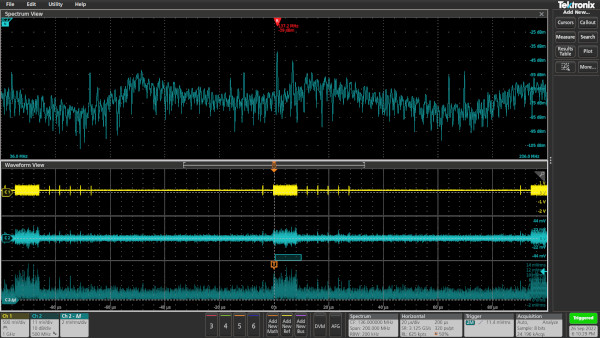
EMI 문제를 일으키는 복사성 방출의 원인을 제거하려면 방출의 구성 요소를 식별하는 것이 중요합니다. 다음으로, 어그레서와 결합 메커니즘을 식별해야 합니다. 4, 5 또는 6 시리즈 MSO와 같은 혼합 도메인 오실로스코프를 스펙트럼 뷰와 함께 사용하면 스펙트럼과 시간 도메인 파형의 동기화된 뷰를 캡처하여 문제의 원인을 신속하게 식별할 수 있습니다.
- 아날로그 채널을 파형이나 스펙트럼으로 또는 두 가지로 모두 볼 수 있음
- RF 주파수 또는 진폭 변경 시 도표 작성 및 트리거링
- 스펙트럼과 시간 도메인 파형이 동기화되어 RF 및 시간 도메인 이벤트의 상관관계를 분석하여 근본 원인을 더 빠르게 식별 가능
- 중심 주파수와 RBW 등의 스펙트럼 제어 기능이 시간 도메인 제어와 독립적으로 작동하여 스펙트럼 및 파형 표시를 최적화 가능
4, 5, 6 시리즈 MSO 오실로스코프를 사용한 단계별 EMI 문제 해결 애플리케이션 노트
주요 콘텐츠
새로운 EMCVu, 일체형 EMI/EMC 사전 적합성 소프트웨어 솔루션
비디오
이제 엔지니어는 신제품 설계가 테스트 시설에 제출할 준비가 되었는지 판단할 수 있는 쉽고 빠르며 정확하고 경제적인 방법을 확보했습니다. 이 비디오에서는 다양한 표준에 대한 푸시 버튼 지원, 자동화된 다중 측정/다중 형식 보고, 주변 소음 교정 및 비교, 피크 탐지기를 사용하는 고속 스캔 및 고조파 마커, 준피크 및 평균 탐지기 실패를 갖춘 점 측정 등 새로운 EMCVu 기능을 설명합니다.
스펙트럼 분석기를 사용하여 경제적인 가격으로 EMI 사전 컴플라이언스 테스트 수행
애플리케이션 노트
이 애플리케이션 노트는 범용 스펙트럼 분석기를 사용하여 복사성 방출 및 전도성 방출에 대해 EMI 사전 컴플라이언스 검사를 수행하여 설계를 컴플라이언스 실험실에 보내기 전에 중요한 문제를 식별할 수 있도록 도와 줍니다.
EMI 적합성 챔버와 텍트로닉스 스펙트럼 분석기 비교
비디오
이 비디오에서는 전체 적합성 리시버 설정을 사용해 얻은 EMI 적합성 결과와 텍트로닉스 RSA 스펙트럼 분석기를 사용하는 저렴한 접근 방법을 비교해 봅니다. 이러한 결과가 의도하지 않은 라디에이터 방출 테스트 및 EMI 챔버 안팎의 CISPR 11 EMI 전도성 방출 테스트와 어떤 관계가 있는지 확인하시게 됩니다. RSA 스펙트럼 분석기 제품군을 사용해 사전 적합성 테스트를 수행하면 적합성 테스트를 실시하기 전에 해결할 수 있는 문제를 탐지하는 데 도움을 받을 수 있으며, 처음에 고가의 적합성 테스트를 진행하지 않음으로써 시간과 비용이 절약됩니다.
Frequently Asked Questions (FAQ)
What is EMI?
Sometimes called radio frequency interference (RFI), electromagnetic interference (EMI) occurs when electromagnetic energy disrupts the operation of an electronic device. The source of EMI can be man-made, such as other electrical devices like switch-mode power supplies, personal computers, or naturally occurring, such as electrical storms, solar radiation, or even cosmic noises.

What is EMC?
Electromagnetic compatibility (EMC) is the ability of a device to operate as intended in an environment with other electrical devices or sources of EMI without affecting those other devices. A device is said to be EMC-compliant when it does not influence the electromagnetic environment to the extent that other devices and systems are negatively affected.
What is EMI and EMC testing?
To ensure compliance with EMI and EMC national and international regulations, many companies employ the services of a specialized testing facility. Since these tests are expensive—even if the product fails—several companies perform EMC pre-compliance testing in-house. If they have a sophisticated enough lab, companies may also perform EMC compliance testing in-house.
What is EMI pre-compliance testing?
What are the types of EMC tests?
When electronics are submitted to EMC testing labs, there are many types of EMC tests these labs run. Generally speaking, EMC testing is divided into two categories: immunity testing and emissions testing.
Immunity testing
Immunity testing is the process of transmitting RF energy onto a device under test (DUT) (also referred to as equipment under test or EUT) to determine if the DUT/EUT operates correctly when in such an environment.
Emissions testing
Emissions testing is the process of measuring the RF emissions – both radiated and conducted – of a DUT/EUT to determine if its emissions levels do not exceed the limits defined by the appropriate standard. Emissions testing includes both radiated and conducted emissions tests.
- Radiated emissions: Radiated emissions are the intentional and unintentional release of electromagnetic energy from an electronic device. A radiated test is performed to ensure emissions emanating from the DUT or EUT comply with the applicable limits.

-
Conducted emissions: Conducted emissions are the coupling of electromagnetic energy from a device to its power cord. Like radiated emissions, the allowable conducted emissions from electronic devices are controlled by different regulatory agencies and testing is performed to ensure emission levels are below the applicable limits.
-

What types of EMC testing labs are there?
EMC-compliance tests are commonly done off-site prior to the production of a device. Open-air test sites, or OATS, are the reference sites used for most standards. They are especially useful for emissions testing of large equipment systems. However, RF testing of a physical prototype is more often carried out indoors, in a specialized anechoic chamber. Types of chambers include anechoic, reverberation, and the gigahertz transverse electromagnetic cell (GTEM cell).
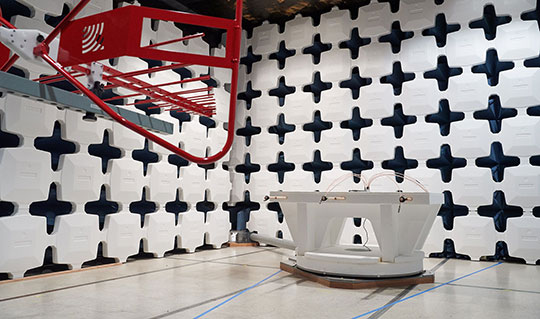
What is EMC testing procedure and average pass rate?
Roughly 50 percent of products pass their first EMC compliance test when pre-compliance isn’t considered, so it’s essential to understand the process and standards a device is tested to in order to increase your chances of success.
- Know your standards: There are a variety of EMC standards that specify test procedures and limits for radiated and conducted emissions. These vary by country and type of equipment under test. The first step in testing is determining which standards apply to your product, and researching the testing procedures and limits required for compliance.
- Conduct pre-compliance EMC testing: EMC compliance testing can take up to two weeks to complete—not including the time it takes to get your product into the test queue—and can cost up to $20,000 per submission. A failure in EMC compliance can result in expensive redesigns and product launch delays. And since nearly 50 percent of products fail their first EMC compliance test when pre-compliance isn’t considered, it’s likely that you’ll need to repeat your visit to the test house, multiplying costs over time.
- Find an EMC testing lab: Once a product has gone through pre-compliance testing and passed the test with a sufficient margin, it needs to be formally certified by an EMC testing lab. Accredited labs are the gold-standard for EMC testing and choosing an accredited lab is always recommended—though not necessary—to ensure your device is ready to go to market. There are, however, some instances that require certification from an FCC-accredited lab, including devices that fall under the 'certification' authorization procedures.
What products are needed for EMI and EMC testing?
The goal of EMC pre-compliance testing is to mimic the compliance test set up within an acceptable margin to uncover potential problems and reduce risk of failure prior to the expensive compliance test. EMC pre-compliance testing typically involves:
- Spectrum analyzer with quasi-peak detector
- Preamplifier (optional)
- Antenna with non-metallic stand for radiated emissions
- Line impedance stabilization network (LISN) for conducted test
- Power limiter for conducted test
- EMC near-field probes for diagnostics (optional)
- Oscilloscope with frequency and time correlation capabilities to assist in debugging (optional)
- EMC testing software
How to set up a pre-compliance EMC test lab?
When selecting a test site, rural areas, conference rooms, and basements are good options because they minimize external signals that might mask the DUT emission levels you are trying to measure. Other considerations for improving accuracy include having a good ground plane and reducing the number of reflective objects around the test area.
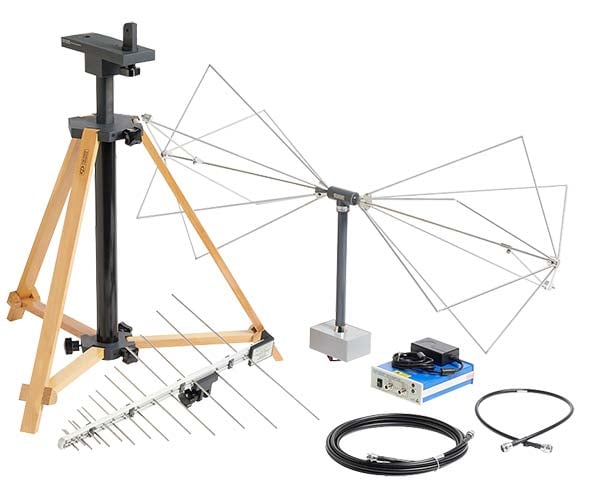
How to pass EMC compatibility testing?
EMC pre-compliance testing is a fast and affordable way to ensure products pass EMC tests the first time In the early development stages, design-for-EMC techniques are combined with diagnostics to build products with low susceptibility to both external and internal interference. Later in the development cycle, pre-compliance testing is used to catch compliance problems and improve the probability of a successful first pass of full EMC-compliance testing.
Additional benefits of pre-compliance EMC testing, include:
- Detects errors early, fixing potential issues
- Lowers testing and design costs
- Projects become more agile
- Lowers risk of failure and leads to assured compliance
- Addresses both over and under design and engineering
- Full EMI Compliance Chamber vs Tektronix Spectrum Analyzer



